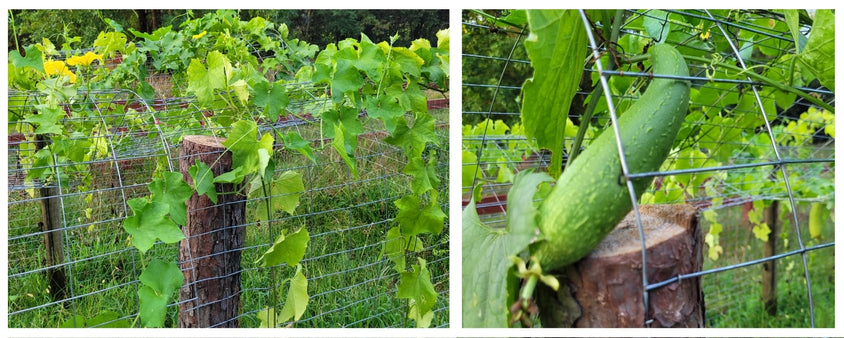How I Grew Loofah Sponges and What I learned
Loofahs are great scrubbers. We know this. You can get organic expensive loofahs, loofahs in soap, cheap loofas at the Walmart and Target. But how much do you really know about them?
I believed for a long time that loofas are sea sponges. I was wrong! There are sea sponges, but they are softer and come from the sea, obviously. I see them often as face washing scrubbers. Loofas are hard core, like REALLY get in there and scrub that dirt off or sweat stains from all the new humidity I found in Arkansas. They are edible when young then turn fibrous as they mature into what we know as loofahs.


And so my journey in falling in love with loofas began as I read up more about them. If you're interested in growing your own, click here for the seeds I am selling to share the joys of growing your own loofahs. Or read on and find out why I called them little bastards and then decide if you want to try it. I still love them though, don't get me wrong.
We moved our business and lives from the desert Southwest to the River Valley of Arkansas. It's gorgeous. Green and vibrant...and humid. We decided to plant a garden - vegetables, several grape vines and I wanted loofahs.
We tilled a large portion for a first year garden. Tested it and it was ok soil, not great but seemed ok. We love to repurpose items so we took cedar logs and made the support posts and put wire on them. I realized a bit too late that cattle wire is different from what I purchased. instead of having a perfect and pretty arch I had saggy, imperfect middles...story of my life. It still works. The loofahs were fine with it and so it stands ready for the 2023 growing season!




I ordered my seeds and did my research and thought I was all set.
In 2022 we got a freak snow storm in mid March and I knew from the research that loofahs are very sensitive to frost and cold. So I started my seeds inside in compost pots with a grow light. They took forever! In reality it took about 2 weeks to emerge. The seeds are quite hard and I did soak them and give them a bit of a scratch. Some didn't poke out for 3+ weeks!

We get alot of winter and spring rain so I finally got them planted outside in the beginning of April. Any chance of frost was gone so I thought I was safe. I left them in their compost pots as it said I could and planted each along the droopy trellis.
And here's where the little bastards part comes in. They barely grew! I watched them, I loved them, I talked to them, I cheered them on but I definitely didn't need to water them because there was so much rain. Nothing. I had hardened them off - putting them in real sun during the day and bringing them inside the house at night to make sure they adjusted and it still meant nothing. NOTHING! Then FINALLY one started growing. The vines slowly started creeping up the trellis and we were making progress! I was excited. Then I finally got a little loofah. Then the others started flowering and growing fruits too. By June I had a small crop growing and I was happy.




Loofahs are anxious little plants. If they don't like something (sun, rain, temperature, being put in the ground, ANYTHING) they can decide to hibernate for a month and not do much. And this is exactly what happened to me. Even with the best intensions I still scared them into a frozen panic of nothingness. They did recover and then grew quite quickly. Just be aware that this can easily happen, If your growing season is short make plans for the worst and hope for the best!
The first loofah is pictured here. It was matured on the vine and I picked it after it had turned fully brown and I could hear the seeds rattling inside the gourd. I was so excited. I opened it up and all the seeds were white, meaning they weren't going to germinate and grow if planted. I was just excited that I finally had a loofah!


Others matured and I harvested them. Then summer hit back. Intense sun and no rain, for weeks at a time. I watered the loofas, but it's not the same as rain. The entire garden would rejoice and expand and bloom every time it rained just to shrivel and hide in the subsequent weeks of no rain. And so it went for the next 2 months. We had a good rain late in summer and I had a bunch of blossoms that matured and stayed on the vines, but it was so late that I had to pick them before they were ready because of a temperature drop and frost. Arkansas weather is apparently famous for being unpredictable. Frost one day and 80 degrees 2 days later. I kept the not ripe loofahs inside and they did dry out and brown. I harvested the fat black seeds which were good, the loofahs were smaller in general but just as good as the others.
So Here's What I Learned and What I'll Do Different This Year
1. The soil was actually not that great. It has a high content of clay and I doubt it had many nutrients. I have already submitted samples to the local extension office for a detail analysis. And it's FREE! I would recommend everyone do this. I have about 2 weeks until the results come back. I'll share when I get them. None of the vegetables in the garden did very well, not just the loofahs.
2. I will start my loofas indoors again but I have been thinking about a heating mat to help them germinate quicker and some of the other vegetable seeds as well. Some didn't show for well over 2 weeks and I thought they were dead. Some did not sprout at all. They are little bastards and this should be expected. But I'll give them every opportunity to grow!
3. I'm in zone 6a. The growing season is quite long BUT the sun is so very intense. I think I will work on trying to give some afternoon shade to the loofahs. The grapes are right next to the loofas and the ones that did the best grew towards the shade! The had afternoon shade and thrived. And then started climbing the poor cedar tree. I had to watch them.
4. When I transplant them outside I'll give them all strings to start growing on before reaching the metal fencing trellis. The few I had on strings grew quicker and better than the ones I put on the trellis immediately.
5. I'll fertilize them mid summer. And hopefully we will have a better rain schedule. The rain vs well water I used to water them can't be compared. They need natural rain.
6. I will use cardboard in the rows to keep the weeds down. The loofas are close to the field that is currently overgrown. We couldn't keep up with the giant garden and the building and all the other things that needed attention so the loofahs had some serious weeds in the rows. I tried to keep them away from the plants as best I could. This year I'll make a better plan from the start and not try to just barely manage after they get ridiculous.
7. I won't wait until they are completely brown and shriveled to pick them. The outside skin gets hard and crusty. It'll crack so you can peel it but it's hard and you have to flake it off piece by little piece. The ones I peeled when yellow with spots of brown still had water content in the skins and were so much easier to peel.
8. I grew my loofahs organically. I assume that since loofahs aren't grown much in my area that pests weren't familiar with the plants. I thought that the squash bugs might migrate from the zucchinis but that didn't really happen! Bees and ants loved them. I didn't notice any harm from the ants so I left them alone unless they had a giant hill near where I had to weed. Those things bite HARD! When I did see a few pests I found that Neem oil worked great. On the grapes too which were much harder hit with pests, and more frequently.
Here's my disclaimer: I'm not an expert! These are my obvious observations from my first try at growing the amazing little bastards. Mistakes were made! And now we level up and try again.
I gave some to friends, I use some to scrub pots and pans. And since the summers here are unbelievably sweaty I love the scrubby fibers to feel super clean (until you go outside again anyway). You can wash them so they stay hygienic. Even bleach won't hurt them. It'll just take the natural color out if you soak them a while.
The remaining ones I'm saving for a rainy day. I have been thinking about making some soap and putting them inside the bars. Maybe painting with them for some unique textures. And of course it's nice to have them for guests. I'm hoping with the adjustments this year to get a bigger yield!
Are you convinced? Want to grow your own? Get your seeds here and also realize that not ALL of them will sprout. Little bastards.
Also read the AI generated how to grow loofah article here. It gives a few more generic details I didn't put in this article because it was in that one!

